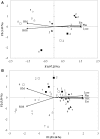Short-Term Exposure of Mytilus coruscus to Decreased pH and Salinity Change Impacts Immune Parameters of Their Haemocytes
- PMID: 29559924
- PMCID: PMC5845731
- DOI: 10.3389/fphys.2018.00166
Short-Term Exposure of Mytilus coruscus to Decreased pH and Salinity Change Impacts Immune Parameters of Their Haemocytes
Abstract
With the release of large amounts of CO2, ocean acidification is intensifying and affecting aquatic organisms. In addition, salinity also plays an important role for marine organisms and fluctuates greatly in estuarine and coastal ecosystem, where ocean acidification frequently occurs. In present study, flow cytometry was used to investigate immune parameters of haemocytes in the thick shell mussel Mytilus coruscus exposed to different salinities (15, 25, and 35‰) and two pH levels (7.3 and 8.1). A 7-day in vivo and a 5-h in vitro experiments were performed. In both experiments, low pH had significant effects on all tested immune parameters. When exposed to decreased pH, total haemocyte count (THC), phagocytosis (Pha), esterase (Est), and lysosomal content (Lyso) were significantly decreased, whereas haemocyte mortality (HM) and reactive oxygen species (ROS) were increased. High salinity had no significant effects on the immune parameters of haemocytes as compared with low salinity. However, an interaction between pH and salinity was observed in both experiments for most tested haemocyte parameters. This study showed that high salinity, low salinity and low pH have negative and interactive effects on haemocytes of mussels. As a consequence, it can be expected that the combined effect of low pH and changed salinity will have more severe effects on mussel health than predicted by single exposure.
Keywords: Mytilus coruscus; acidification; flow cytometry; haemocyte; immune response; salinity.
Figures



Similar articles
-
Hemocyte responses of the thick shell mussel Mytilus coruscus exposed to nano-TiO2 and seawater acidification.Aquat Toxicol. 2016 Nov;180:1-10. doi: 10.1016/j.aquatox.2016.09.008. Epub 2016 Sep 12. Aquat Toxicol. 2016. PMID: 27642706
-
Combined effects of ZnO NPs and seawater acidification on the haemocyte parameters of thick shell mussel Mytilus coruscus.Sci Total Environ. 2018 May 15;624:820-830. doi: 10.1016/j.scitotenv.2017.12.168. Epub 2017 Dec 27. Sci Total Environ. 2018. PMID: 29274606
-
Combined effects of seawater acidification and high temperature on hemocyte parameters in the thick shell mussel Mytilus coruscus.Fish Shellfish Immunol. 2016 Sep;56:554-562. doi: 10.1016/j.fsi.2016.08.012. Epub 2016 Aug 10. Fish Shellfish Immunol. 2016. PMID: 27521590
-
Effects of short-term hypoxia and seawater acidification on hemocyte responses of the mussel Mytilus coruscus.Mar Pollut Bull. 2016 Jul 15;108(1-2):46-52. doi: 10.1016/j.marpolbul.2016.05.001. Epub 2016 May 18. Mar Pollut Bull. 2016. PMID: 27207025
-
The Eco-Immunological Relevance of the Anti-Oxidant Response in Invasive Molluscs.Antioxidants (Basel). 2023 Jun 13;12(6):1266. doi: 10.3390/antiox12061266. Antioxidants (Basel). 2023. PMID: 37371996 Free PMC article. Review.
Cited by
-
Transgenerational exposure to ocean acidification impacts the hepatic transcriptome of European sea bass (Dicentrarchus labrax).BMC Genomics. 2023 Jun 15;24(1):331. doi: 10.1186/s12864-023-09353-x. BMC Genomics. 2023. PMID: 37322468 Free PMC article.
-
Aquatic Organisms in Response to Salinity Stress: Ecological Impacts, Adaptive Mechanisms, and Resilience Strategies.Biology (Basel). 2025 Jun 9;14(6):667. doi: 10.3390/biology14060667. Biology (Basel). 2025. PMID: 40563918 Free PMC article. Review.
-
Diseases of marine fish and shellfish in an age of rapid climate change.iScience. 2024 Aug 28;27(9):110838. doi: 10.1016/j.isci.2024.110838. eCollection 2024 Sep 20. iScience. 2024. PMID: 39318536 Free PMC article. Review.
-
Influence of environmental variables on macroinvertebrate community structure in Lianhuan Lake.Ecol Evol. 2022 Feb 14;12(2):e8553. doi: 10.1002/ece3.8553. eCollection 2022 Feb. Ecol Evol. 2022. PMID: 35222949 Free PMC article.
References
-
- Bakhmet I. N., Berger V. J., Khalaman V. V. (2005). The effect of salinity change on the heart rate of Mytilus edulis specimens from different ecological zones. J. Exp. Mar. Biol. Ecol. 318, 121–126. 10.1016/j.jembe.2004.11.023 - DOI
-
- Bibby R., Widdicombe S., Parry H., Spicer J., Pipe R. (2008). Effects of ocean acidification on the immune response of the blue mussel Mytilus edulis. Aquat. Biol. 2, 67–74. 10.3354/ab00037 - DOI
LinkOut - more resources
Full Text Sources
Other Literature Sources
Research Materials

